Day 2 of a long weekend of tours today – an Owl Tour. It was windy again, but not as bad as yesterday, and with some glorious winter sunshine in the afternoon. (NB Photos from today are somewhat more limited than usual – & some here are from previous days – due to a camera malfunction, in this case an iPhone6 which went from 90% charged at 8am to 0% by 9.30am without being used. Thank you very much, Apple!)
First pick-up was in Wells, where most of the group were waiting, but two more were to join us in Blakeney. Just on the few miles along the coast road between the two this morning, we had our first two Barn Owls. Hopefully a good start to the day…
From Blakeney, we swung round the back of Wiveton. Crossing the bridge, we could see our first Barn Owl of the tour proper, hunting the meadows beyond. We stopped on the bridge, but immediately found ourselves with cars behind – it was obviously rush hour – so we pulled over further along and walked back. The Barn Owl was now hunting back and forth along the back of the meadows, dropping down from time to time into the grass, but only coming back up empty-taloned, at least while we were watching. It then worked its way along the hedge line towards us, almost up to the road, before heading off away up the hill, through the gardens towards the village.
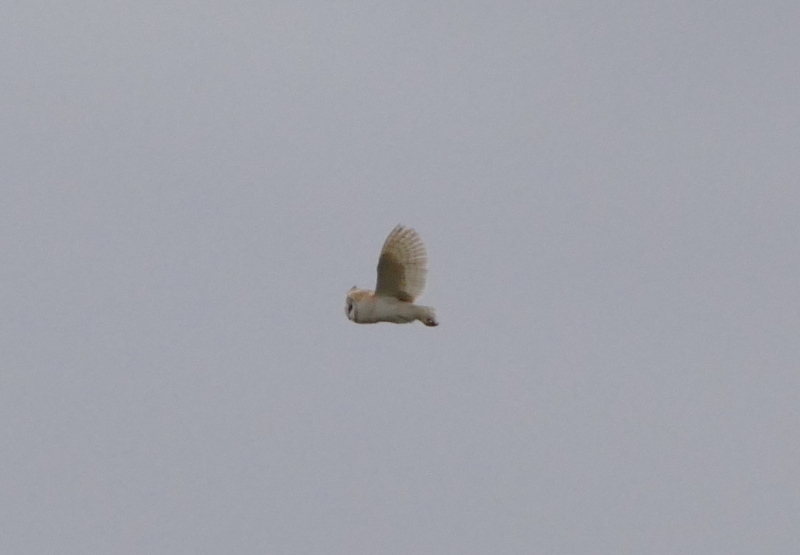 Barn Owl – several were out hunting this morning
Barn Owl – several were out hunting this morning
Working our way round, we came across another Barn Owl out hunting. After rain overnight and such strong winds yesterday, they were probably trying to make the most of the conditions to feed. It was perched in a tree at first, but took off and started hunting a quiet field corner, sheltered among the trees. When we lost sight of it, we walked back towards the car and there it was on a signpost behind. Unfortunately, it flew when it saw us and resumed hunting over a different field beyond.
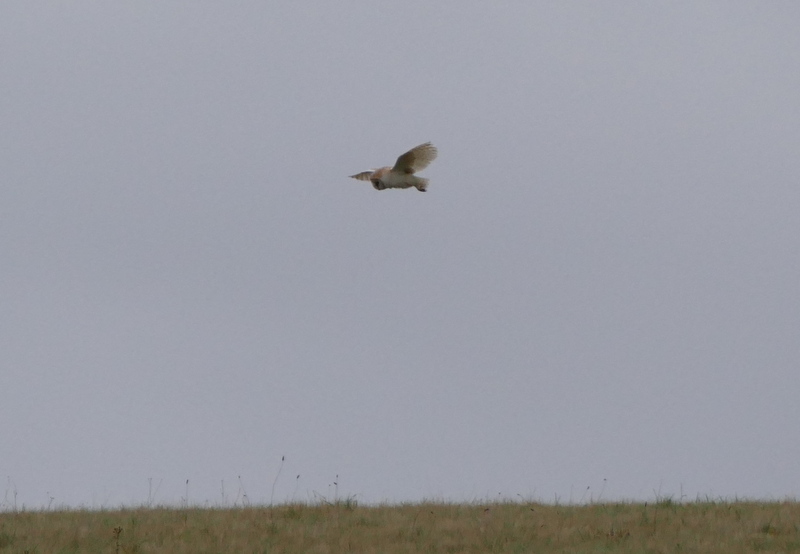 Barn Owl – hunting over a grassy field, looking out for voles
Barn Owl – hunting over a grassy field, looking out for voles
We watched the Barn Owl for some time. It flew out of view over the top of the field, appeared to go across the road, then turned and came back past us. We marveled at the way it flew silently, its attention focused on the ground almost all the time. Eventually it flew off away from us and out of sight.
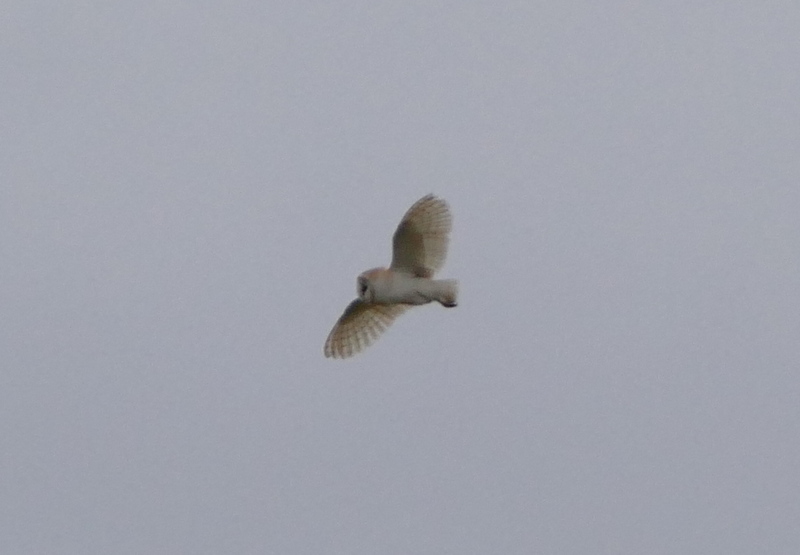 Barn Owl – eventually flew away across the fields and out of view
Barn Owl – eventually flew away across the fields and out of view
There were other birds to see here too. A Cetti’s Warbler called and flew from the undergrowth in front of us – and we actually saw it for a few seconds out in the open before it disappeared again. A smart male Bullfinch perched up on the top of the hedge, picking at some old blackberries. A Redpoll flew overhead calling. A Common Buzzard was displaying half-heartedly over the hill beyond.
We drove on and up to a favoured site for Little Owl. It was still cloudy, and cold in the wind, and it felt like any self-respecting Little Owl would be tucked down somewhere warm. We couldn’t find one in its usual spot, but a careful scan over the farm buildings and we found a small ball of feathers perched up on a low roof. It had found a place where it was out of the wind and looking towards the rising sun, with a few shafts of sunlight were just about showing through the clouds. It stayed there all the time we were there, looking round occasionally but otherwise in no hurry to go anywhere.
Our attention was gradually drawn away from the Little Owl, as there were other things to see here as well. Another Barn Owl flew through the trees on the verge, tantalising us with glimpses as it flew in and out before melting away into the vegetation. A small group of Fieldfares flew in noisily and landed in the trees. A tight group of Golden Plover flew over, heading inland. A couple of Brown Hares were doing their best impression of clods of earth, flattening themselves low into the winter wheat, trying to keep down out of the wind.
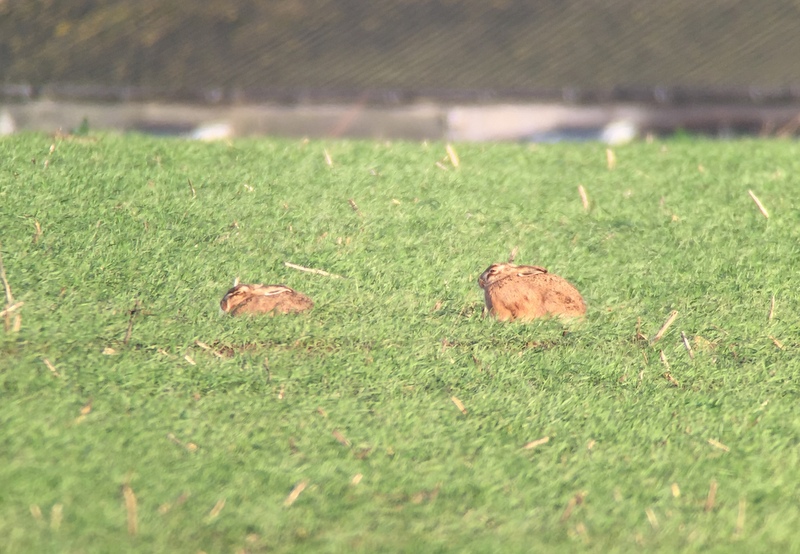 Brown Hares – this photo from a couple of weeks ago
Brown Hares – this photo from a couple of weeks ago
We had done very well with owls this morning and with the day getting on, we decided to move on to something else. We made our way down to the coast road and along to Burnham Overy Staithe. It was windy up on the seawall, but the wind was at our backs on the way out. There was a large flock of Brent Geese feeding on the grazing marshes below us and a quick scan revealed one which looked slightly different.
Most of the Brent Geese we get here in Norfolk are Dark-bellied Brent Geese from Russia. Occasionally we get a Black Brant, a different subspecies of Brent Goose from Eastern Siberia or the NW of North America, in with our Dark-bellieds and sometimes they pair up and interbreed. The Brent Goose we were looking at today was one of these hybrids – a little darker than a Dark-bellied Brent, with a slightly paler flank patch and better marked white collar, but none of those features were as strong as they should be on a pure Black Brant. This bird has been returning here for many winters, always to the same fields, and is a regular pitfall for the unwary.
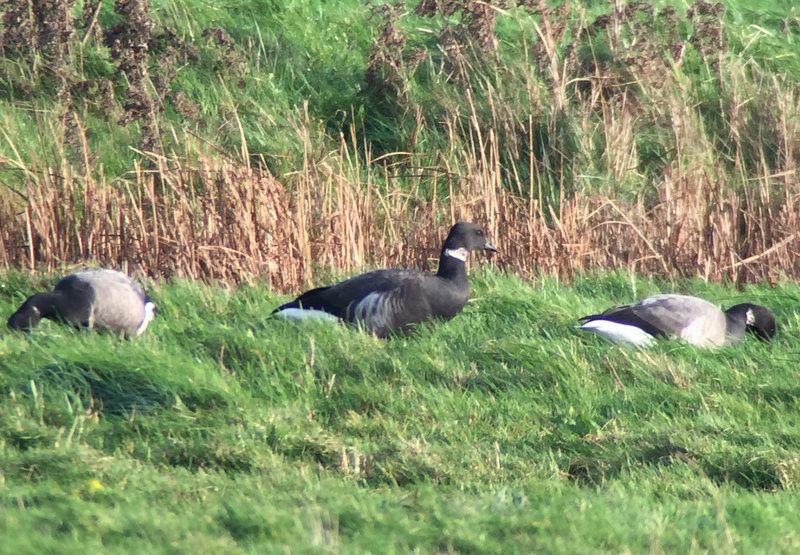 Black Brant hybrid – a regular at Burnham Overy, photographed a few weeks ago
Black Brant hybrid – a regular at Burnham Overy, photographed a few weeks ago
The tide was in and there were no waders out in the harbour on the way out. However there were huge numbers of waders on the fields. They were all up in the air as we walked out, vast clouds of birds swirling round, before dropping back down onto the grass. There were more than 1,000 Golden Plover and slightly fewer but still a lot of Lapwings which formed the bulk of them. A tight group of smaller Dunlin twisted and turned in formation low over the grass and reeds. When we got to the corner of the seawall, we could see them all out on the grazing meadows. There were lots of Curlew too. Then they all took to the air again, taking all the Brent Geese with them – the birds were clearly very nervous in the wind.
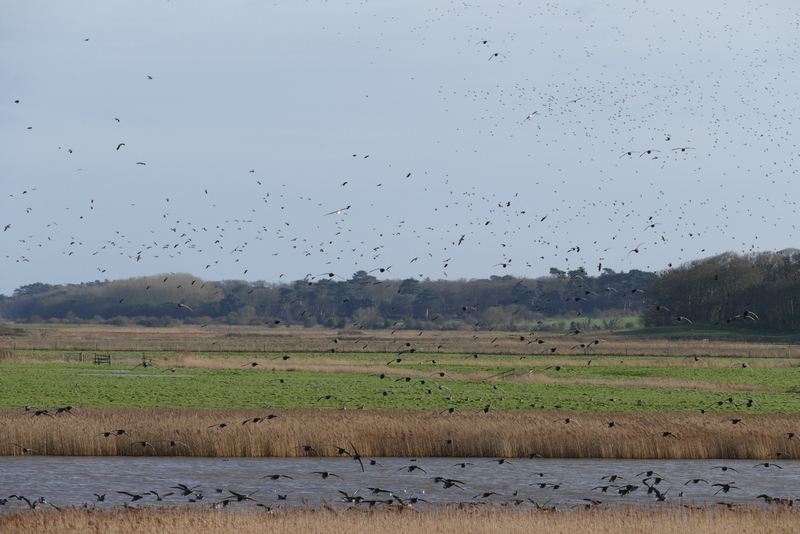 Waders and geese – swirling over the grazing marshes
Waders and geese – swirling over the grazing marshes
We got our heads down and made our way out to the dunes. We had hoped it might be more sheltered on the other side but with the wind having gone round further west, it was whistling along the beach as well. We turned and headed into it, scanning the tide line and the edge of the dunes ahead of us. We had come to look for the Shore Larks which have been here on and off for some time now, but we were told on our way out that they had not been seen this morning. Still, we looked hard to try to find them.
We did find lots of Sanderling, running around on the beach like silver and white clockwork toys. Further out, on a shingle ridge, more waders were roosting over high tide. Through the scope we could see lots of Ringed Plovers, blackish Turnstones contrasting with more pale Sanderlings and several Dunlin in with them.
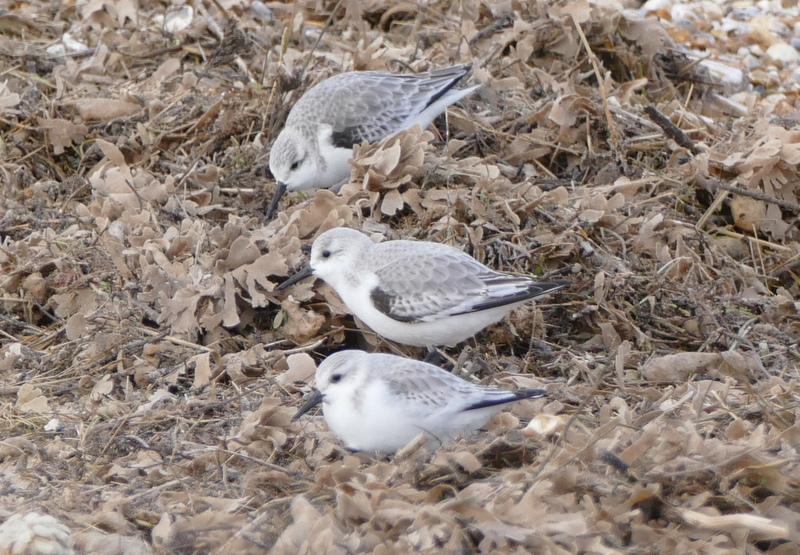
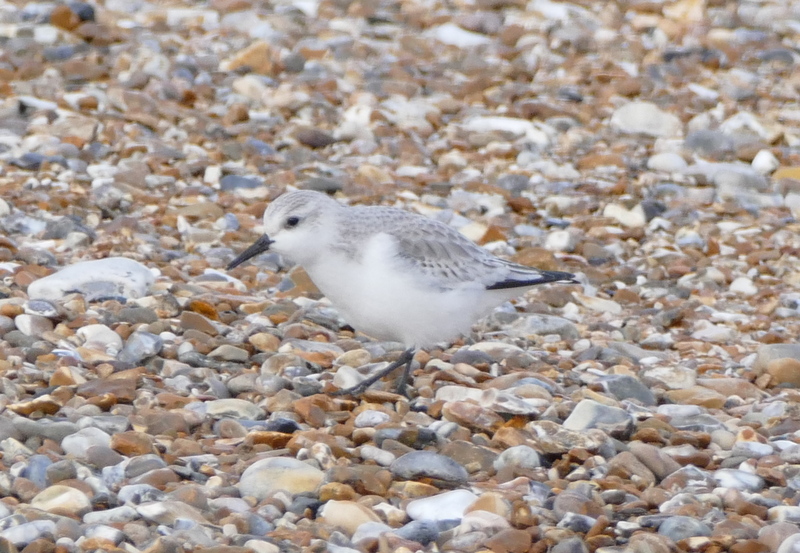 Sanderlings – up on the beach over high tide
Sanderlings – up on the beach over high tide
We were some way along towards the end of the beach before we met a photographer coming the other way, lugging a big lens. We expected another negative report but we were thrilled instead to learn that the Shore Larks were there, right at the very west end of the beach. We quickened our step and soon found ourselves there… but where were the birds? It took us a short while before we found them. They had been tucked down in all the debris on the tide line and flew out a short distance onto the stones as we approached. We backed off, but they flew again, thankfully landing only a little further back.
We approached cautiously and, having seen where they landed could get close to the Shore Larks without disturbing them. This time we got them in the scope – we could see their yellow faces and black masks, even at times the little horns on the top of their heads. Even better, the clouds then parted and the sun came out. The yellow positively glowed in the sunshine, as they fed unobtrusively picking at the dead vegetation which had been washed into piles on the shore.
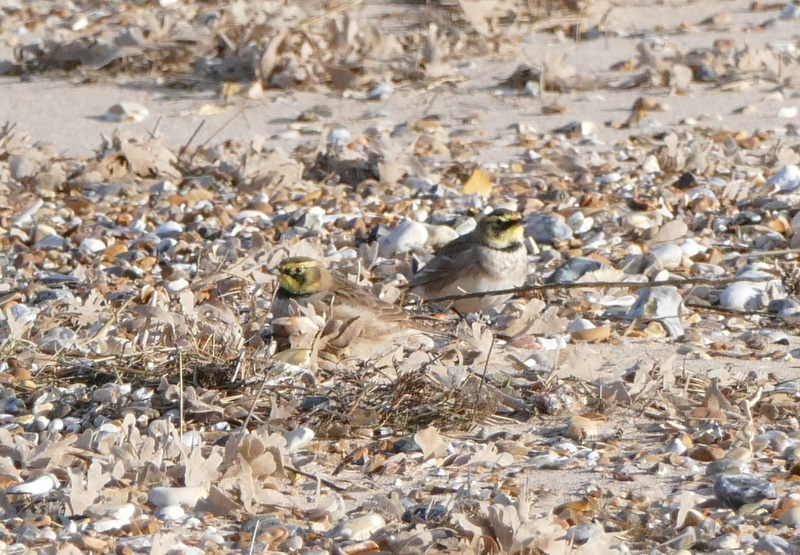
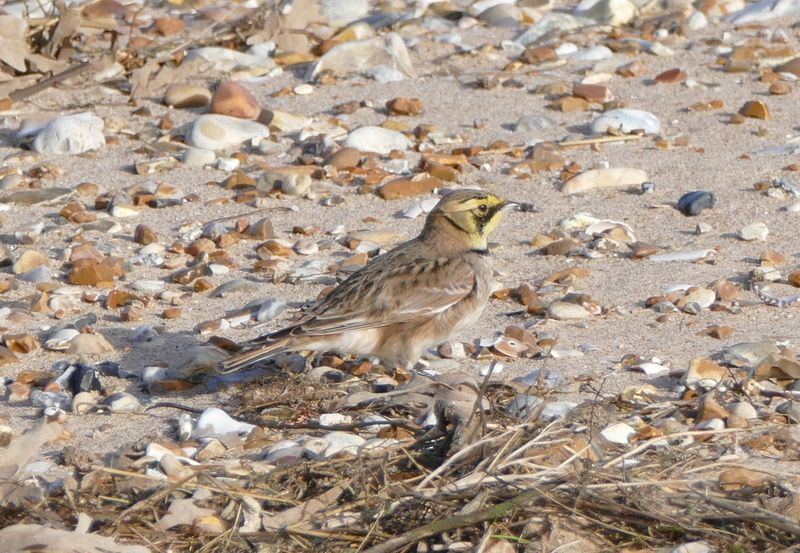 Shore Larks – the best efforts from today, without digiscoping
Shore Larks – the best efforts from today, without digiscoping
The Shore Larks flew back along the beach to where they had been earlier and again allowed the photographers in the group to get close. There was plenty for the rest of us to look at. A Red-breasted Merganser was diving in the channel between us and Scolt Head. Further over, we could see several waders roosting on an island, Bar-tailed Godwits, Grey Plovers and Oystercatchers. Despite the wind, it was a fantastic place to be, out on the beach in the winter sunshine.
 Photographing the Shore Larks – looking towards Scolt Head in the sunshine
Photographing the Shore Larks – looking towards Scolt Head in the sunshine
After everyone had finished taking photos, the Shore Larks seemed to realise they had completed their photo session as they flew off down the beach and out of sight. We decided to head back – we were so enjoying the walk with the sun, and wind, at our backs that we had forgotten about the Shore Larks until they suddenly flew up from the beach right in front of us. Cue more admiring looks and clicking of shutters. Eventually we had to tear ourselves away.
 Shore Lark – one from Burnham Overy the other day, digiscoped
Shore Lark – one from Burnham Overy the other day, digiscoped
 Shore Lark – and another, check out the little ‘horns’
Shore Lark – and another, check out the little ‘horns’
We stopped to admire the flock of Golden Plover on the way back, spread out across the grass. The tide had gone out now, so there were lots of waders on the mud in the harbour. We could see white-spangled Grey Plover and smaller grey, dumpy Knot out with all the Redshanks. Along the edge of the harbour channel, we could see ten Bar-tailed Godwits. We were almost back to the village when we found another three Red-breasted Mergansers in the channel, this time including a smart drake.
It was lunchtime when we got back, but we decided to make our way somewhere more sheltered to eat. We stopped briefly by the road at Holkham on the way back to scan the grazing marshes. It didn’t take long to find a few White-fronted Geese hiding in with all the Greylags. The more we looked, the more we found, scattered in small groups across the grass. Several Marsh Harriers quartered the marshes, scattering all the Wigeon as they went.
We made our way back along the coast to Blakeney after lunch. There was no sign of any of the Barn Owls along the coast road where they had been this morning, or at any of their other usual spots. When we parked by the harbour at Blakeney, another Red-breasted Merganser was preening, standing in the shallow water in the channel.
We walked out along the seawall, scanning the marshes for owls, but it was very exposed out there this afternoon. The wind had picked up and was whistling across and it was rather cold. A smart male Marsh Harrier was circling over the reeds, its pale grey wings catching the sun, before landing down on some brambles. Behind it, another harrier appeared, smaller and slimmer, paler below and with a small, square white patch at the base of the uppertail – a ringtail Hen Harrier. It worked its way slowly along the edge of the reeds, before disappearing behind them out of view.
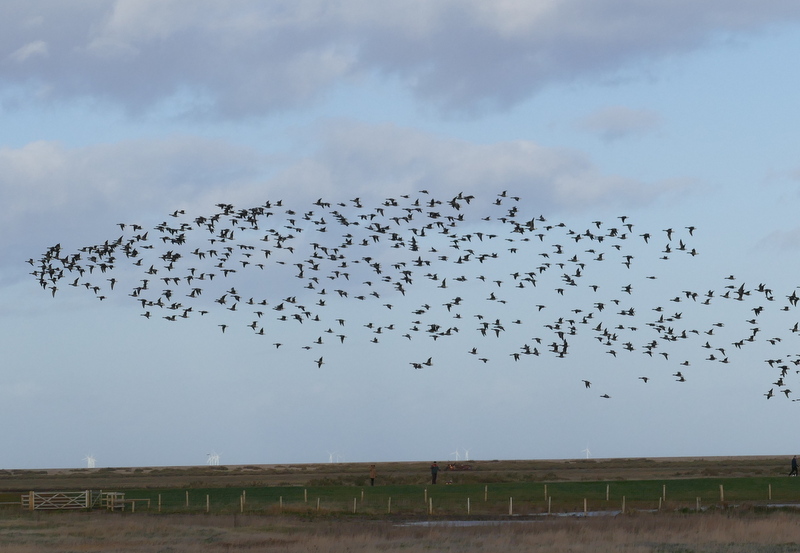 Brent Geese – a small part of the flock at Blakeney this afternoon
Brent Geese – a small part of the flock at Blakeney this afternoon
In the absence of owls, we had hoped to see the Lapland Buntings which have taken up residence out here for the winter, but there was no sign of them at first. Then we saw a small bird fly up briefly and drop straight down into the long grass again. We made our way over to where we had seen it. All we could find at first were Skylarks, but the vegetation here was thick and tall with just the odd gap. The more we looked, the more Skylarks appeared – there were many more than we had realised in here. Then a different bird stuck its head up, a rounded head with rusty cheeks, a Lapland Bunting. It was just a glimpse and most of the group missed it, but at least we knew they were in here.
A frustrating few minutes followed – every bird which we could find in the grass turned out to be a Skylark. Then just as we were about to give up, everything took off. The only bird to call gave a hard, dry rattle ‘pt-t-t-t-t’, Lapland Bunting again. Twenty or thirty birds flew up high into the sky and among the larger Skylarks we could see at least 4 slightly smaller Lapland Buntings. One of them landed in the slightly shorter grass further along the path, but before we could get there it was off again with a few Skylarks, back to where it had been. We went back and couldn’t see it, but as we stood there, two more Lapland Buntings dropped back in. Not great views, but in the circumstances, with the wind, possibly the best we could hope for. On the walk back, we stopped to admire a pair of Stonechats, feeding low down in the Suaeda bushes by the path.
 Stonechat – the female of the pair feeding by the path
Stonechat – the female of the pair feeding by the path
The afternoon was getting on by this stage. We decided to have a quick drive round to see if any of the Barn Owls were out, but all was quiet again. Perhaps it was just too windy again now. Anyway we had a date in the woods to get to. We made sure we were in position in good time tonight, and still didn’t have to wait too long until a Tawny Owl hooted from high up in the trees in front of us. After a few minutes it called again. Then a large dark shape appeared from deep in the ivy, big rounded wings flapping, and glided down and away through the trees. Unfortunately, rather than perching up for us as it often does, today it carried on back and disappeared out of view. Perhaps the wind was too strong high up in the trees, or it had just seen us below.
It seemed like that might be that for a couple of minutes. None of the other Tawny Owls were hooting tonight and this one had gone quiet. Then it started hooting again, deep in the trees. Suddenly it came straight out towards us and over into the trees behind. It was out of view and when we tried to work our way round it was off again. It went up into some tall trees and started hooting again. We could see it perched high up and got it in the scope, but unfortunately it flew again before everyone could get a look at it. A Woodcock flew out of the trees and away overhead.
We could still hear the Tawny Owl, but it was getting dark now and impossible to find in all the branches. It was time to call it a day, and we walked back to the car to the sound of it hooting.
















